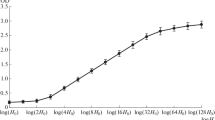Abstract
The DNA in the macronucleus of a hypotrichous ciliate occurs as millions of short molecules packed into dense chromatin bodies 0.1–2 μm in diameter. We have studied by electron microscopy the organization of DNA molecules in these chromatin bodies of macronuclei lysed in water at pH 9. Proteinase K treatment of lysed macronuclei progressively releases from chromatin bodies many rosettes of DNA molecules bound at one or both ends to a central core of protein. With longer treatment with proteinase K, rosettes disappear, leaving individual free DNA molecules. We propose that, in the native state, both ends of DNA molecules are bound through telomere-binding protein to a central core to form rosettes. Many rosettes, with collapsed DNA loops, aggregate to form a chromatin body. Chromatin bodies are believed to dissociate into individual collapsed rosettes to form the granules in the forward zone of the replication band. In the rear zone of the band, the rosettes dissociate, presumably as a result of release of telomere-binding protein, which is preliminary to the replication of the DNA molecules.
Similar content being viewed by others
References
Foissner W, Berger H (1999) Identification and ontogenesis of the nomen nudum Hypotrichs (Protozoa: Ciliophora) Oxytricha nova (= Sterkiella nova sp. n.) and O. trifallax (= S. histriomuscorum). Acta Protozool 38: 215–248.
Gall JG (1959) Macronuclear duplication in the ciliated protozoan Euplotes. J Biochem Biophys Cytol 5: 295–308.
Gottschling DE, Zakian VA (1986) Telomere proteins: specific recognition and protection of the naturalt ermini of Oxytricha macronuclear DNA. Cell 47: 195–205.
Kleinschmidt AK (1968) Monolayer techniques in electron microscopy of nucleic acid molecules. Methods Enzymol 12: 361–377.
Kloetzel JA (1970) Compartmentalization of the developing macronuclei following conjugation in Stylonychia and Euplotes. J Cell Biol 47: 395–407.
Lauth MR, Spear BB, Heumann J, Prescott DM (1976) DNA of ciliated protozoa: DNA sequence diminution during macronuclear development of Oxytricha. Cell 7: 67–74.
Lipps HJ (1980) In vitro aggregation of the gene-sized DNA molecules of the ciliate Stylonychia mytilus. Proc Natl Acad Sci USA 77: 4104–4107.
Murti KG (1973) Electron microscopic observations on the macronuclear development of Stylonychia mytilus and Tetrahymena pyriformis (Ciliophora-Protozoa). J Cell Sci 13: 479–509.
Murti KG (1976) Organization of genetic materialin the macronucleus of hypotrichous ciliates. In: King RC, ed. Handbook of Genetics. New York: Plenum Press, pp 113–137.
Murti KG, Prescott DM (1978) Electron microscopic visualization of transcribed genes in the nucleus of Amoeba proteus. Exp Cell Res 112: 233–240.
Murti KG, Prescott DM (1983) Replication forms of the gene-sized DNA molecules of hypotrichous ciliates. Mol Cell Biol 3: 1562–1566.
Murti KG, Prescott DM(1999) Telomeres of polytene chromosomes in a ciliated protozoan terminate in duplex DNA loops. Proc Natl Acad Sci USA 96: 14436–14439.
Murti KG, Prescott DM, Péne JJ (1972) DNA of ciliated protozoa. III. Binding of RNA polymerase and denaturation at the ends of the low molecular weight DNA in Stylonychia. J Mol Biol 68: 413–416.
Postberg J, Juranek SA, Feiler S, Kortwig H, Jonsson F, Lipps HJ (2001) Association of the telomere–telomere-binding protein complex of hypotrichous ciliates with the nuclear matrix and dissociation during replication. J Cell Sci 114: 1861–1866.
Prescott DM (1994) The DNA of ciliated protozoa. Microbiol Rev 58: 233–267.
Prescott DM, Kimball RF (1961) Relation between RNA, DNA, and protein syntheses in the replicating nucleus of Euplotes. Proc Natl Acad Sci USA 47: 686–693.
Raikov I (1968) The macronucleus of ciliates. In: Chen TT, ed. Research in Protozoology New York: Pergamon Press, pp. 1–128.
Seegmiller A, Williams KR, Herrick G (1997) Two two-gene macronuclear chromosomes of the hypotrichous ciliates Oxytricha fallax and O. trifallax generated by alternative processing of the 81 locus. Dev Genet 20: 348–357.
Swanton MT, Heumann JM, Prescott DM (1980) Gene-sized DNA molecules of the macronuclei in three species of hypotrichs: Size distributions and absence of nicks. Chromosoma 77: 217–227.
Author information
Authors and Affiliations
Rights and permissions
About this article
Cite this article
Murti, K.G., Prescott, D.M. Topological organization of DNA molecules in the macronucleus of hypotrichous ciliated protozoa. Chromosome Res 10, 165–173 (2002). https://doi.org/10.1023/A:1014957303627
Issue Date:
DOI: https://doi.org/10.1023/A:1014957303627




